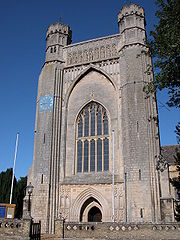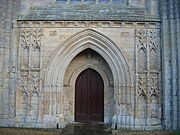
Thorney Abbey
Encyclopedia


Thorney, Cambridgeshire
Thorney is a village about 8 miles east of Peterborough in the City of Peterborough unitary authority, England, on the A47. Historically it was part of the Isle of Ely, which was considered part of Cambridgeshire but was transferred into the former county of Huntingdon and Peterborough and...
in The Fens
The Fens
The Fens, also known as the , are a naturally marshy region in eastern England. Most of the fens were drained several centuries ago, resulting in a flat, damp, low-lying agricultural region....
of Cambridgeshire
Cambridgeshire
Cambridgeshire is a county in England, bordering Lincolnshire to the north, Norfolk to the northeast, Suffolk to the east, Essex and Hertfordshire to the south, and Bedfordshire and Northamptonshire to the west...
, England
England
England is a country that is part of the United Kingdom. It shares land borders with Scotland to the north and Wales to the west; the Irish Sea is to the north west, the Celtic Sea to the south west, with the North Sea to the east and the English Channel to the south separating it from continental...
.
History
The earliest documentary sources refer to a mid-7th century hermitageHermitage (religious retreat)
Although today's meaning is usually a place where a hermit lives in seclusion from the world, hermitage was more commonly used to mean a settlement where a person or a group of people lived religiously, in seclusion.-Western Christian Tradition:...
destroyed by a Viking
Viking
The term Viking is customarily used to refer to the Norse explorers, warriors, merchants, and pirates who raided, traded, explored and settled in wide areas of Europe, Asia and the North Atlantic islands from the late 8th to the mid-11th century.These Norsemen used their famed longships to...
incursion in the late 9th century. A Benedictine
Benedictine
Benedictine refers to the spirituality and consecrated life in accordance with the Rule of St Benedict, written by Benedict of Nursia in the sixth century for the cenobitic communities he founded in central Italy. The most notable of these is Monte Cassino, the first monastery founded by Benedict...
monastery
Monastery
Monastery denotes the building, or complex of buildings, that houses a room reserved for prayer as well as the domestic quarters and workplace of monastics, whether monks or nuns, and whether living in community or alone .Monasteries may vary greatly in size – a small dwelling accommodating only...
was founded in the 970s, and a huge rebuilding programme followed the Norman Conquest of 1066. A new church was begun under the abbacy of Gunther of Le Mans, appointed in 1085. It was in use by 1089, but not entirely finished until 1108.
The focus of the settlement shifted away from the fen edge in the late 12th or early 13th century, the earlier site becoming a rubbish dump, perhaps because of encroaching water. It was reoccupied in the 13th and 14th centuries, when clay layers were laid down to provide a firm foundation for the timber buildings. More substantial buildings were erected in the 16th century and these are thought to have been part of an expanding abbey
Abbey
An abbey is a Catholic monastery or convent, under the authority of an Abbot or an Abbess, who serves as the spiritual father or mother of the community.The term can also refer to an establishment which has long ceased to function as an abbey,...
complex, perhaps for use as guesthouses, stables, or workshop
Workshop
A workshop is a room or building which provides both the area and tools that may be required for the manufacture or repair of manufactured goods...
s.
Much of Thorney Abbey disappeared without trace after the Dissolution of the Monasteries
Dissolution of the Monasteries
The Dissolution of the Monasteries, sometimes referred to as the Suppression of the Monasteries, was the set of administrative and legal processes between 1536 and 1541 by which Henry VIII disbanded monasteries, priories, convents and friaries in England, Wales and Ireland; appropriated their...
. Its last abbot, Robert Blythe, was a supporter of the King, having signed a letter to the pope urging that his divorce should be allowed. He was rewarded with a pension of £200 a year. The abbey was surrendered to the king's commissioners on 1 December 1539, and most its buildings were later demolished and the stone reused.
The nave of the church survived, and was restored as the Parish Church of St Mary and St Botolph in 1638. At this date the aisles were demolished and the arcade openings walled up. The present east end, in the Norman style, is by Edward Blore
Edward Blore
Edward Blore was a 19th century British landscape and architectural artist, architect and antiquary. He was born in Edinburgh, Scotland ....
, and dates from 1840-1.
There is a model of the monastery in the Thorney Museum.
The name Thorney Abbey is also given to a house, partly late sixteenth and partly seventeenth century, in the village of Thorney.
Excavation
Excavation was undertaken in 2002 prior to redevelopment, by University of Leicester Archaeological Services. This focused on the northern edge of the former island. As well as pottery, animal bone and roofing material, a large deposit of 13th and 14th century painted glass was found in and around the buildings. The intricate designs were of very high quality.External links
- Parish of Thorney in the City of Peterborough
- Abbey of Thorney from VCH
- Thorney Abbey - Catholic Encyclopedia
- The Calendar and the Cloister, website dedicated to Oxford, St John's College MS 17, an early 12th-century manuscript produced at Thorney Abbey.

